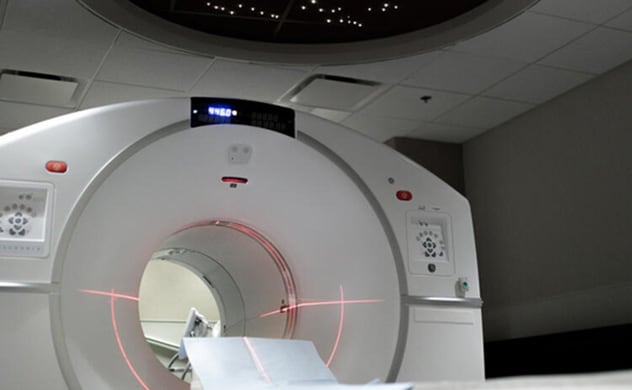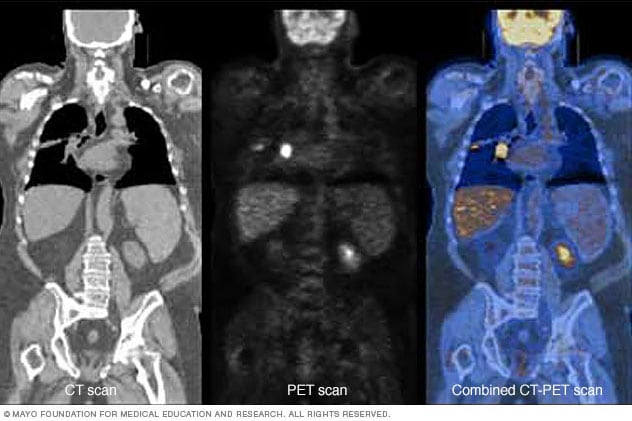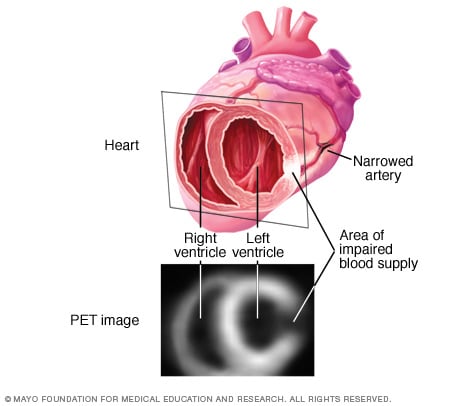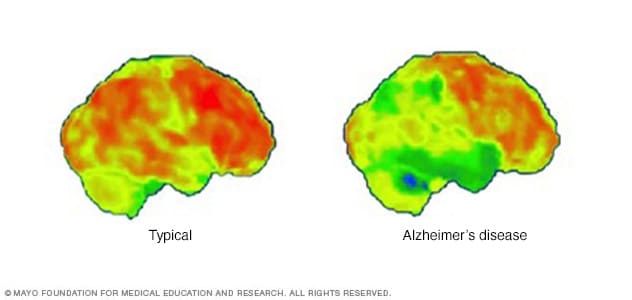Overview
Positron emission tomography

Positron emission tomography
During a positron emission tomography (PET) scan, you lie on a narrow table that slides into a doughnut-shaped hole. The scanner takes about 30 minutes to produce detailed images of metabolic activity in your tissues and organs.
A positron emission tomography (PET) scan is an imaging test that can help reveal the metabolic or biochemical function of the body's tissues and organs. The PET scan uses a radioactive drug called a tracer to show both typical and atypical metabolic activity. A PET scan can often detect the atypical metabolism of the tracer in diseases before the disease shows up on other imaging tests, such as computerized tomography (CT) and magnetic resonance imaging (MRI).
The tracer is most often injected into a vein within your hand or arm. The tracer will then collect into areas of your body that have higher levels of metabolic or biochemical activity. This often pinpoints the location of the disease. The PET images are typically combined with CT or MRI and are called PET-CT or PET-MRI scans.
Products & Services
Why it's done
A PET scan is an effective way to help discover a variety of conditions, including cancer, heart disease and brain disorders. A healthcare professional can use this information to help diagnose, monitor or treat your condition.
Cancer
PET plus CT

PET plus CT
Combining a PET scan with an MRI or CT scan can help make the images easier to interpret. At left is a CT scan, while the center image is a PET scan. The image on the right is a combined PET-CT scan. The bright spot in the chest, seen best on the PET and PET-CT scans, is lung cancer.
Cancer cells show up as bright spots on PET scans because they have a higher metabolic rate than do typical cells. PET scans may be useful in:
- Detecting cancer.
- Revealing whether your cancer has spread.
- Checking whether a cancer treatment is working.
- Finding a cancer recurrence.
PET scans must be interpreted carefully because noncancerous conditions can look like cancer. Also, some cancers do not appear on PET scans. Many types of solid tumors can be detected by PET-CT and PET-MRI scans, including:
- Brain.
- Breast.
- Cervical.
- Colorectal.
- Esophageal.
- Head and neck.
- Lung.
- Lymphatic system.
- Pancreatic.
- Prostate.
- Skin.
- Thyroid.
Heart disease
PET scan of the heart

PET scan of the heart
This PET image shows an area of reduced blood flow from one of the arteries that feeds the heart. This information may help doctors decide whether to suggest bypass surgery or angioplasty to restore that blood flow.
PET scans can reveal areas of decreased blood flow in the heart. This information can help you and your healthcare professional decide, for example, whether you might benefit from coronary artery bypass surgery or a procedure to open clogged heart arteries, called angioplasty.
Brain disorders
PET scans of the brain for Alzheimer's disease

PET scans of the brain for Alzheimer's disease
A PET scan can compare a typical brain (left) with one affected by Alzheimer's disease (right). The loss of red color with an increase in yellow, blue and green colors shows areas of decreased metabolic activity in the brain due to Alzheimer's disease.
PET scans can be used to check certain brain disorders, such as tumors, Alzheimer's disease and seizures.
More Information
Risks
For your PET scan, a radioactive drug called a tracer will be injected into a vein. Because the amount of radiation you're exposed to in the tracer is small, the risk of negative effects from the radiation is low. But the tracer might:
- Expose your unborn baby to radiation if you are pregnant.
- Expose your child to radiation if you are breastfeeding.
- Cause an allergic reaction, although this is rare.
Talk with a healthcare professional about the benefits and risks of a PET scan.
How you prepare
Tell your healthcare professional:
- If you've ever had a bad allergic reaction.
- If you've been sick recently or you have another medical condition, such as diabetes.
- If you're taking any medicines, vitamins or herbal supplements.
- If you're pregnant or you think you might be pregnant.
- If you're breastfeeding.
- If you're afraid of enclosed spaces, a condition known as claustrophobia.
Your health professional will give you detailed instructions on how to prepare for your scan. A general rule is to avoid strenuous exercise for a couple of days before the study and to stop eating four hours before the scan.
What you can expect
The PET-CT or PET-MRI scanner is a large machine that looks a little like a giant doughnut standing upright, similar to CT or MRI scanners.
From start to finish, the procedure takes about two hours to complete and typically does not require an overnight hospital stay. When you arrive for your scan, you may be asked to:
- Change into a hospital gown.
- Empty your bladder.
A member of your healthcare team injects the tracer into a vein in your arm or hand. You may briefly feel a cold sensation moving up your arm. You rest and remain silent in a reclining chair for 30 to 60 minutes while the tracer is absorbed by your body.
During the procedure
When you are ready, you lie on a narrow, padded table that slides into the part of the scanner that looks like a doughnut hole. During the scan you must be very still so that the images aren't blurred. It takes about 30 minutes to complete a PET-CT scan and 45 minutes for a PET-MRI scan. The machine makes buzzing and clicking sounds.
The test is painless. If you're afraid of enclosed spaces, you may feel some anxiety while in the scanner. Be sure to tell the nurse or technologist about any anxiety causing you discomfort. You may be given medicine to help you relax.
After the procedure
After the test you can carry on with your day as usual, unless your health professional tells you otherwise. You'll need to drink plenty of fluids to help flush the tracer from your body.
Results
A specialist trained to interpret scan images, called a radiologist, will report the findings to your healthcare team.
The radiologist may compare your PET images with images from other tests you've undergone recently, such as an MRI or CT. Or the PET images may be combined to provide more detail about your condition.
Clinical trials
Explore Mayo Clinic studies of tests and procedures to help prevent, detect, treat or manage conditions.